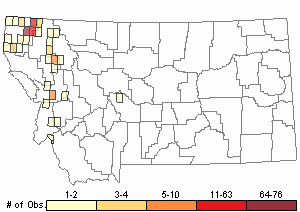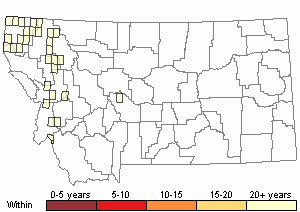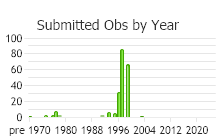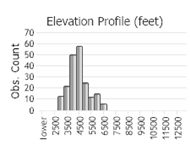View in other NatureServe Network Field Guides
NatureServe
Montana
Utah
Wyoming
Idaho
Wisconsin
British Columbia
South Carolina
Yukon
California
New York
A Squirrel-tail Moss - Sciuro-hypnum hylotapetum
Other Names:
Brachythecium hylotapetum
General Description
Plants: Growing in open interwoven mats (Lawton1971) or open upright clumps, very shiny, pale green or with yellow tinges to whitish. Stems prostrate to upwardly inclined, or upright in crowded conditions, erratically pinnately branched, circular to flattened in X-section, to 10 cm in length; possessing a central strand. Branches weakly to quite flattened in X-section, to 16 mm in length, curved or a little bent and twisted (FNA 2014).
Leaves: Stem leaves distant, spreading somewhat (FNA 2014) to loosely appressed (Lawton 1971), 2.2-3.7 mm in length, 1.3-2 mm in width, widely egg-shaped, somewhat cupped, not pleated longitudinally; base extending down the stem slightly; margins flat or curved back and down near the attachment, nearly smooth to finely saw-toothed, the apical margins more toothed; apex with an abrupt or short tapering point; costa ca 1/2 the leaf length or a little more, occasionally forked, lacking terminal dorsal teeth. Branch leaves smaller and more slender than the stem leaves, with more teeth (FNA 2014).
Leaf Cells: Alar cells larger than cells adjacent to the costa, fine-walled, the alar area unclearly demarcated; laminal cells long and thin; basal cells wider than and not as long as the laminal cells (FNA 2014), porose (Lawton 1971), in 3-4 series (FNA 2014).
Diagnostic Characteristics
The large size, long leaves (often more than 3 mm), and pale color make this plant easy to recognize (FNA 2014).
Range Comments
North American Range
Pacific Northwest, AK, CA, ID, MT, CO (FNA 2014). Known in Montana from Beaverhead, Flathead, Lake, Lincoln, Mineral, and Missoula Counties (Elliott 2016).
Observations in Montana Natural Heritage Program Database
Number of Observations: 236
(Click on the following maps and charts to see full sized version)
Map Help and Descriptions
Relative Density

Recency



 (Observations spanning multiple months or years are excluded from time charts)
(Observations spanning multiple months or years are excluded from time charts)
Habitat
Soil, litter, rotting wood in coniferous forest (Elliott 2016). Elevations: 2620-4920 feet (FNA 2014).
Reproductive Characteristics
Dioicous. Fruit quite rare. Seta 1-3 cm tall, brown to red with purple tones, papillae-roughened. Capsule 15-25 mm in length, somewhat red, level (FNA 2014) to occasionally drooping; cilia transversely ridged (Lawton 1971).
Stewardship Responsibility
References
- Literature Cited AboveLegend:
 View Online Publication
View Online Publication Elliott, J.C. and A.K. Pipp. 2018. A Checklist of Montana Mosses (1880-2018). Updated 3 January, 2020. Montana Natural Heritage Program, Helena, Montana. 73 pp.
Elliott, J.C. and A.K. Pipp. 2018. A Checklist of Montana Mosses (1880-2018). Updated 3 January, 2020. Montana Natural Heritage Program, Helena, Montana. 73 pp. Flora of North America Editorial Committee, eds. 2014. Flora of North America North of Mexico. Volume 28. Bryophytes: Mosses, Part 2. Oxford University Press, Inc., NY. xxi + 702 pp.
Flora of North America Editorial Committee, eds. 2014. Flora of North America North of Mexico. Volume 28. Bryophytes: Mosses, Part 2. Oxford University Press, Inc., NY. xxi + 702 pp. Lawton, E. 1971. Moss Flora of the Pacific Northwest. Hattori Botanical Laboratory. Japan: Yamabuki-cho, Shinjuku-ku, Tokyo. 362 pages plus appendices.
Lawton, E. 1971. Moss Flora of the Pacific Northwest. Hattori Botanical Laboratory. Japan: Yamabuki-cho, Shinjuku-ku, Tokyo. 362 pages plus appendices. Vitt, D. J. Marsh, and R. Bovey. 1988. Mosses, Lichens & Ferns of Northwest North America. Seattle, WA: University of Washington Press. 296 p.
Vitt, D. J. Marsh, and R. Bovey. 1988. Mosses, Lichens & Ferns of Northwest North America. Seattle, WA: University of Washington Press. 296 p.
- Additional ReferencesLegend:
 View Online Publication
View Online Publication
Do you know of a citation we're missing? Elliot, J. C. 1993. Second checklist of Montana mosses. Unpublished report. U.S. Forest Service, Region 1. Missoula, MT. 45 pp.
Elliot, J. C. 1993. Second checklist of Montana mosses. Unpublished report. U.S. Forest Service, Region 1. Missoula, MT. 45 pp. Lawton, E. 1971. Keys for the Identification of the Mosses on the Pacific Northwest. Reprinted from 'Moss Flora of the Pacific Northwest'. Published as Supplement No. 2 of the Journal of the Hattori Botanical Laboratory. Nichinan, Miyazaki, Japan. 66 pp.
Lawton, E. 1971. Keys for the Identification of the Mosses on the Pacific Northwest. Reprinted from 'Moss Flora of the Pacific Northwest'. Published as Supplement No. 2 of the Journal of the Hattori Botanical Laboratory. Nichinan, Miyazaki, Japan. 66 pp. Malcolm, B., N. Malcolm, J. Shevock, and D. Norris. 2009. California Mosses. Nelson, New Zealand: Micro-Optics Press. 430 pp.
Malcolm, B., N. Malcolm, J. Shevock, and D. Norris. 2009. California Mosses. Nelson, New Zealand: Micro-Optics Press. 430 pp.
- Web Search Engines for Articles on "A Squirrel-tail Moss"





